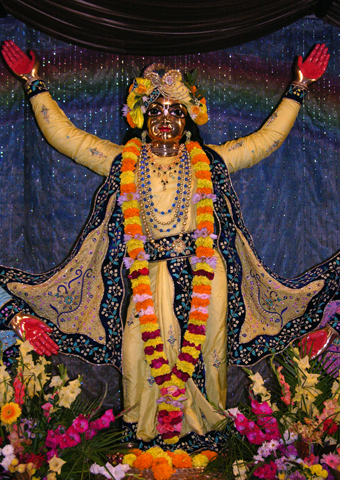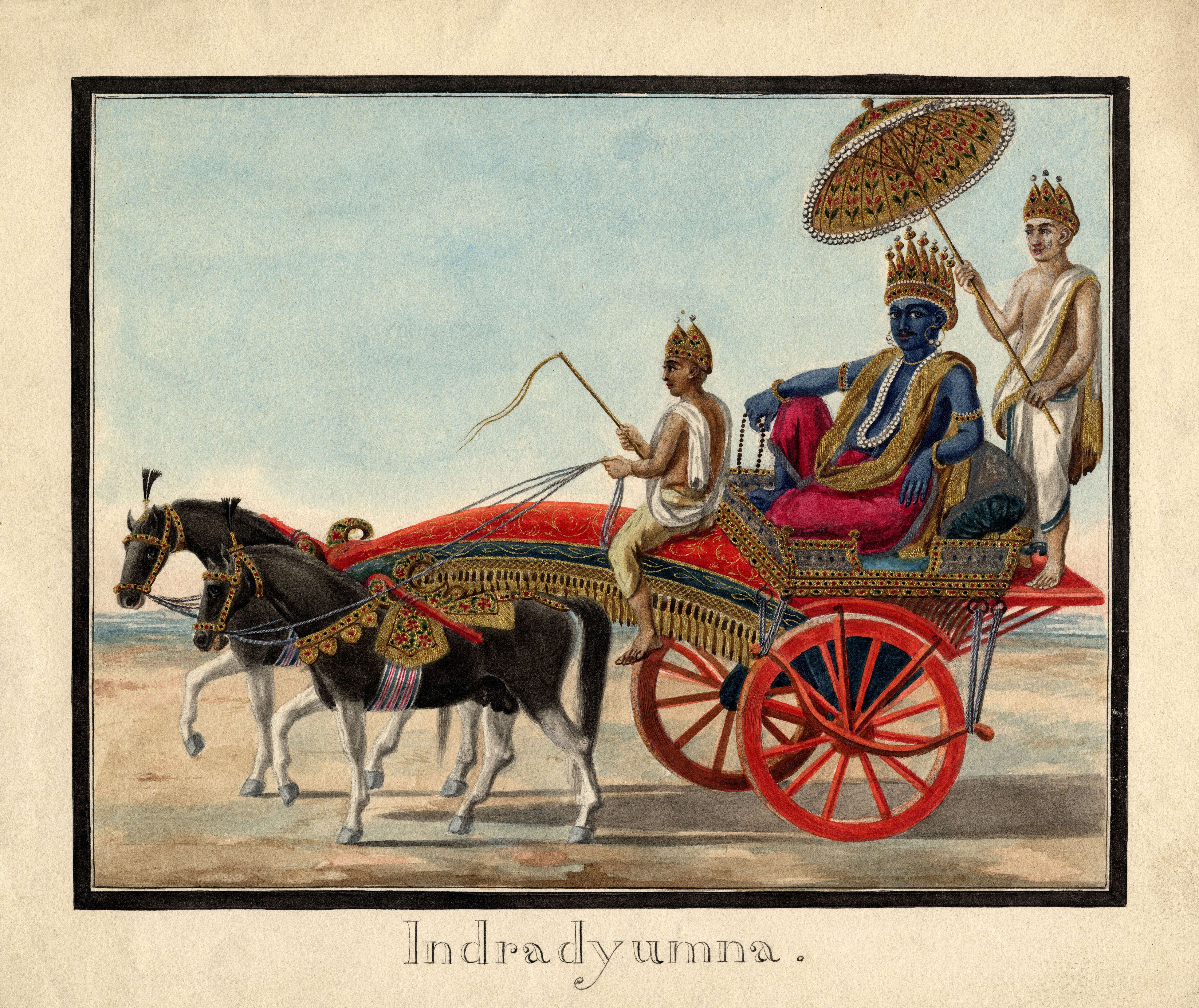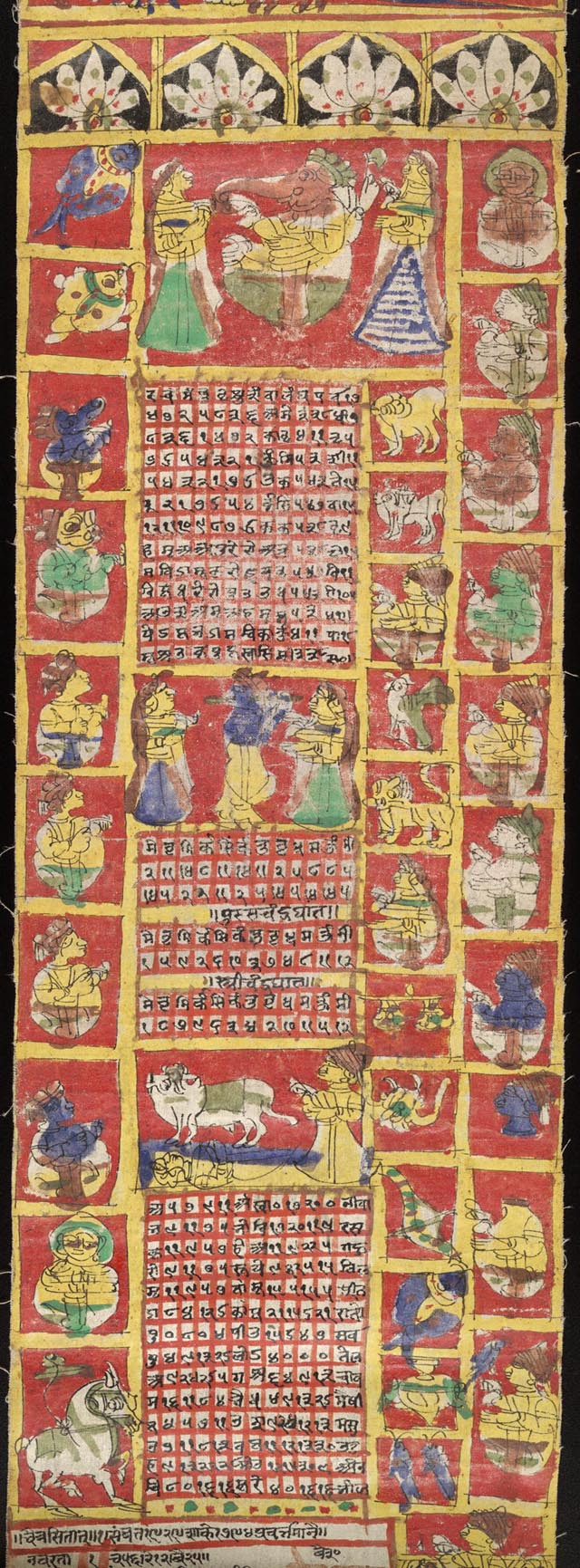|
Baladeva Vidyabhushan
Baladeva Vidyabhushana (; 1700 – 1793 AD) was an Indian Gaudiya Vaishnava acharya (religious teacher) and a prominent Vaishnav saint. He was instrumental in spreading the Gaudiya system beyond the borders of Bengal and Odisha and is especially revered in Rajputana for spreading Vaishnavism there. Early Life Despite being renowned all over the world as the Gaudiya Vedanta Acharya, the scarcity of available authentic bio data has led misinformed authors to spread incorrect information about his life incidents. Early tradition and manuscripts point out that he was born in Utkala, or the present day Odisha. Some believe that he was born near Remuna, Balasore where the famous temple of Khirachora Gopinatha is located. Based on mere assumptions, some have recklessly put forth 1768 as the year of his disappearance. While his birth date is unknown, a document preserved at the Jaipur Archives dated the fourteenth day of the Bhadra month of Saṁvat 1850 (nineteenth of Septem ... [...More Info...] [...Related Items...] OR: [Wikipedia] [Google] [Baidu] |
Vrindavan
Vrindavan (; ), also spelt Vrindaban and Brindaban, is a historical city in the Mathura district of Uttar Pradesh, India. It is located in the Braj, Braj Bhoomi region and holds religious importance for Hindus who believe that Krishna, one of the main Gods in Hinduism, spent most of his childhood in this city. Vrindavan has about 5,500 temples dedicated to the worship of Krishna and his chief consort, Radha. It is one of the most sacred places for Vaishnavism, Vaishnava traditions. Vrindavan forms a part of the "Krishna pilgrimage circuit" under development by the Indian Ministry of Tourism. The circuit also includes Mathura, Barsana, Gokul, Govardhan, Kurukshetra, Dwarka and Puri. Etymology The ancient Sanskrit name of the city, (), comes from its groves of ''vṛndā'' (Ocimum tenuiflorum, holy basil) and ''vana'' (Grove (nature), grove, forest). History Vrindavan has an ancient past, associated with Hindu culture and history, and was established in the 16th and 17t ... [...More Info...] [...Related Items...] OR: [Wikipedia] [Google] [Baidu] |
Utkala Kingdom
Utkala kingdom was located in the northern and eastern portion of the modern-day Indian state of Odisha. This kingdom was mentioned in the epic Mahabharata, with the names ''Utkala'', ''Utpala'', and ''Okkal''. It is mentioned in India's national anthem, Jana Gana Mana. Early Sanskrit Literature The early Sanskrit medieval literature says "उत्कृष्ट कलायाः देशः यः सः उत्कलः" (), meaning the land having an "excellent opulence of artists". The Puranic division of ''Utkala desa'' was bounded on the north by the river Kapisa, on the south by the river Mahanadi, on the east by the Bay of Bengal and to the west by Mekala hills. Mahabharata The Dasarnas, the Mekalas (a kingdom to the west of Utkala) and the Utkalas were mentioned as kingdoms of Bharata Varsha (Ancient India) (6:9). Utkalas were mentioned as taking part in the Kurukshetra War siding with the Kauravas. Many Mekalas, Utkalas, Kalingas, Nishadas, and Tamralip ... [...More Info...] [...Related Items...] OR: [Wikipedia] [Google] [Baidu] |
Vrindavana
Vrindavan (; ), also spelt Vrindaban and Brindaban, is a historical city in the Mathura district of Uttar Pradesh, India. It is located in the Braj Bhoomi region and holds religious importance for Hindus who believe that Krishna, one of the main Gods in Hinduism, spent most of his childhood in this city. Vrindavan has about 5,500 temples dedicated to the worship of Krishna and his chief consort, Radha. It is one of the most sacred places for Vaishnava traditions. Vrindavan forms a part of the "Krishna pilgrimage circuit" under development by the Indian Ministry of Tourism. The circuit also includes Mathura, Barsana, Gokul, Govardhan, Kurukshetra, Dwarka and Puri. Etymology The ancient Sanskrit name of the city, (), comes from its groves of ''vṛndā'' ( holy basil) and ''vana'' ( grove, forest). History Vrindavan has an ancient past, associated with Hindu culture and history, and was established in the 16th and 17th centuries as a result of an explicit treaty ... [...More Info...] [...Related Items...] OR: [Wikipedia] [Google] [Baidu] |
Jiva Gosvami
Jiva Goswami (; ) was an Indian philosopher and saint from the Gaudiya Vaishnava school of Vedanta tradition, producing a great number of philosophical works on the theology and practice of Bhakti yoga, Vaishnava Vedanta and associated disciplines. He is known as one of the Six Goswamis of Vrindavan and was the nephew of the two leading figures, Rupa Goswami and Sanatana Goswami. Biography Genealogy His family lineage can be traced to Indian State of Karnataka and Naihati in the district of North 24 Parganas in present-day West Bengal, India. The former generations according to ''Bhakti-ratnakara'': Sarvajna Jagatguru was a famous brahmana, great scholar in all Vedas, respected Yajur-vedi of the Baradvaja caste, and king of Karnataka in South India, adored by all other contemporary kings. Sarvajna's son, Aniruddha, was spirited, famous, a proficient scholar of the Vedas, and a favourite of the reigning kings at the time. Aniruddha's sons, Rupesvara (eldest) and Harihara, w ... [...More Info...] [...Related Items...] OR: [Wikipedia] [Google] [Baidu] |
Sat-sandarbhas
''Sat Sandarbhas'' (''Six Sandarbhas'', ) is a 16th-century Vaishnava Sanskrit text, authored by Gaudiya Vaishnava theologian Jiva Goswami. The six treatise are ''Tattva-'', ''Bhagavat-'', ''Paramatma-'', ''Krishna-'', ''Bhakti-'', and ''Priti-sandarbha''. Jiva's ''Krama-sandarbha'' commentary on the ''Bhagavata Purana'' is often described as the "seventh" of the six ''sandarbhas''. The ''Six Sandarbhas'' are sometimes called the ''Bhagavata-sandarbha'', not to be confused with the second treatise titled ''Bhagavat-sandarbha''. The word "''sandarbha''" literally means "weaving" or "arranging"; the ''Bhagavata-sandarbha'', his main philosophical work, is a thematic arrangement of the ''Bhagavata Purana'', which presents Chaitanya Vaishnavism in a systematic and comprehensive way. Gupta places this composition as an early work due to references in latter works such as ''Radha-krsnarcana-dipika'', ''Krama-sandarbha'', ''Dig-darsini'', ''Durgama-sangamini'', and ''Gopalacampu''. Brze ... [...More Info...] [...Related Items...] OR: [Wikipedia] [Google] [Baidu] |
Caitanya Mahaprabhu
Chaitanya Mahaprabhu (; ), born Vishvambhara Mishra () (18 February 1486 – 14 June 1534), was an Indian Hindu saint from Bengal and the founder of Gaudiya Vaishnavism. Chaitanya Mahaprabhu's mode of worshipping Krishna with bhajan-kirtan and dance had a profound effect on Vaishnavism in Bengal. He is considered the chief proponent of the Vedantic philosophy of Achintya Bheda Abheda. However, the concept of inconceivable difference in non-difference, known as achintya-bhedabheda, was developed later by Jiva Gosvami in his book Bhagavat Sandharbha. Mahaprabhu founded Gaudiya Vaishnavism. He expounded Bhakti yoga and popularised the chanting of the Hare Krishna Maha-mantra. He composed the '' Shikshashtakam'' (eight devotional prayers). Chaitanya is sometimes called Gauranga () or Gaura due to his molten gold–like complexion. His birthday is celebrated as Gaura-purnima. He is also called Nimai because he was born underneath a Neem tree. Life The religious hagiog ... [...More Info...] [...Related Items...] OR: [Wikipedia] [Google] [Baidu] |
Gaudiya Vaishnava Theology
Gaudiya Vaishnavism (), also known as Chaitanya Vaishnavism, is a Vaishnava Hindu religious movement inspired by Chaitanya Mahaprabhu (1486–1534) in India. "Gaudiya" refers to the Gaura or Gauḍa region of Bengal (present-day Malda district of West Bengal and Rajshahi district of Bangladesh), with Vaishnavism meaning "the worship of Vishnu". Specifically, it is part of Krishnaism–Krishna-centric Vaishnavite traditions. Its theological basis is primarily that of the ''Bhagavad Gita'' and ''Bhagavata Purana'' (known within the tradition as the ''Srimad Bhagavatam''), as interpreted by early followers of Chaitanya, such as Sanatana Goswami, Rupa Goswami, Jiva Goswami, Gopala Bhatta Goswami and others. The focus of Gaudiya Vaishnavism is the devotional worship (known as bhakti yoga) of Radha and Krishna, and their many divine incarnations as the supreme forms of God, ''Svayam Bhagavan''. Most popularly, this worship takes the form of singing Radha and Krishna's holy names, ... [...More Info...] [...Related Items...] OR: [Wikipedia] [Google] [Baidu] |
Puri
Puri, also known as Jagannath Puri, () is a coastal city and a Nagar Palika, municipality in the state of Odisha in eastern India. It is the district headquarters of Puri district and is situated on the Bay of Bengal, south of the state capital of Bhubaneswar. It is home to the 12th-century Jagannath Temple (Puri), Jagannath Temple and is one of the original Char Dham pilgrimage sites for Hindus. Puri has been known by several names since ancient times and was locally known as "Sri Kshetra" and the Jagannath Temple, Puri, Jagannath temple is known as "Badadeula". Puri and the Jagannath Temple were invaded 18 times by Muslim rulers, from the 7th century AD until the early 19th century with the objective of looting the treasures of the temple. Odisha, including Puri and its temple, were part of British India from 1803 until India attained independence in August 1947. Even though princely states do not exist in India today, the heirs of the House of Gajapati still perform the r ... [...More Info...] [...Related Items...] OR: [Wikipedia] [Google] [Baidu] |
Chaitanya Mahaprabhu
Chaitanya Mahaprabhu (; ), born Vishvambhara Mishra () (18 February 1486 – 14 June 1534), was an Indian Hindus, Hindu saint from Bengal and the founder of Gaudiya Vaishnavism. Chaitanya Mahaprabhu's mode of worshipping Krishna with bhajan-kirtan and dance had a profound effect on Vaishnavism in Bengal. He is considered the chief proponent of the Vedantic philosophy of Achintya Bheda Abheda. However, the concept of inconceivable difference in non-difference, known as achintya-bhedabheda, was developed later by Jiva Gosvami in his book Bhagavat Sandharbha. Mahaprabhu founded Gaudiya Vaishnavism. He expounded Bhakti yoga and popularised the chanting of the Hare Krishna (mantra), Hare Krishna Maha-mantra. He composed the ''Shikshashtakam'' (eight devotional prayers). Chaitanya is sometimes called Gauranga () or Gaura due to his molten gold–like complexion. His birthday is celebrated as Gaura-purnima. He is also called Nimai because he was born underneath a Neem tree. ... [...More Info...] [...Related Items...] OR: [Wikipedia] [Google] [Baidu] |
India
India, officially the Republic of India, is a country in South Asia. It is the List of countries and dependencies by area, seventh-largest country by area; the List of countries by population (United Nations), most populous country since 2023; and, since its independence in 1947, the world's most populous democracy. Bounded by the Indian Ocean on the south, the Arabian Sea on the southwest, and the Bay of Bengal on the southeast, it shares land borders with Pakistan to the west; China, Nepal, and Bhutan to the north; and Bangladesh and Myanmar to the east. In the Indian Ocean, India is near Sri Lanka and the Maldives; its Andaman and Nicobar Islands share a maritime border with Thailand, Myanmar, and Indonesia. Modern humans arrived on the Indian subcontinent from Africa no later than 55,000 years ago., "Y-Chromosome and Mt-DNA data support the colonization of South Asia by modern humans originating in Africa. ... Coalescence dates for most non-European populations averag ... [...More Info...] [...Related Items...] OR: [Wikipedia] [Google] [Baidu] |
Pratap Singh Of Jaipur
Sawai Pratap Singh (2 December 1764 – 1 August 1803) was the Kachwaha Rajput ruler of the Kingdom of Jaipur. He was brought on the throne by his mother Maji Chundawatji after the suspicious death of his elder full brother Sawai Prithvi Singh II in 1778. He is known for constructing the magnificent Hawa Mahal in Jaipur in the year 1799. Biography Sawai Pratap Singh was born as a younger son of Sawai Madho Singh I on 2 December 1764. Pratap Singh became the Maharaja at the age of 14 after the death of his elder full brother Sawai Prithvi Singh II. He ruled from the year 1778 to 1803. His 25-year rule witnessed many spectacular achievements and strategic failures. Being constantly goaded by the Marathas and the Mughals, he had to face repeated threats and a heavy drainage of funds by the former. He also made his raj guru Pandit Shiv Narayan Misr the king of Jaipur for 3 days, when he was busy performing religious rituals. Due to court politics, Pandit Shiv Narayan Mishr ... [...More Info...] [...Related Items...] OR: [Wikipedia] [Google] [Baidu] |
Samvat
The Hindu calendar, also called Panchanga (), is one of various lunisolar calendars that are traditionally used in the Indian subcontinent and Southeast Asia, with further regional variations for social and Hindu religious purposes. They adopt a similar underlying concept for timekeeping based on sidereal year for solar cycle and adjustment of lunar cycles in every three years, but differ in their relative emphasis to moon cycle or the sun cycle and the names of months and when they consider the New Year to start. Of the various regional calendars, the most studied and known Hindu calendars are the Shalivahana Shaka (Based on the King Shalivahana, also the Indian national calendar) found in the Deccan region of Southern India and the Vikram Samvat (Bikrami) found in Nepal and the North and Central regions of India – both of which emphasize the lunar cycle. Their new year starts in spring. In regions such as Tamil Nadu and Kerala, the solar cycle is emphasized and this is c ... [...More Info...] [...Related Items...] OR: [Wikipedia] [Google] [Baidu] |





